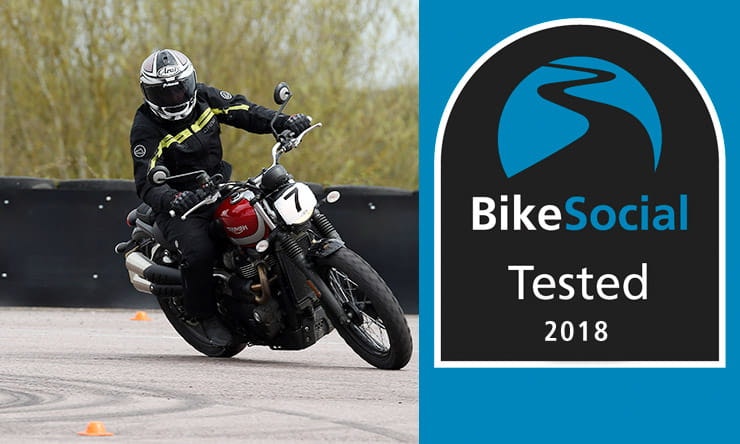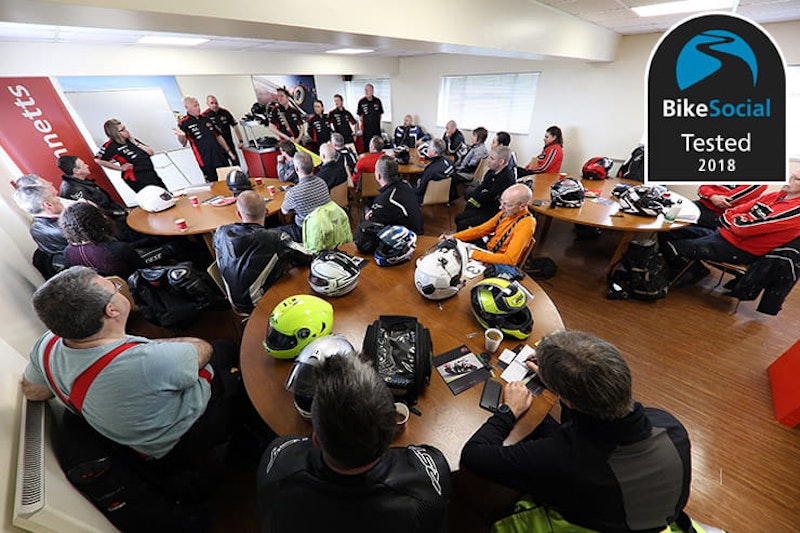Tested: California Superbike School Advanced Rider Training review
By Simon Hancocks
Motorcycle Journalist
16.05.2018
Date reviewed: April 2018 | Tested by: Simon hancocks| Price: From £99 | www.superbikeschool.co.uk
The Bennetts Advanced Rider Training (ART) is a course designed to teach the very basic principles of track riding. It isn’t a trackday as such, and doesn’t require any specialist equipment or clothing other than your own bike, textiles/leathers, boots, gloves and a helmet. The format is relaxed and the teaching is based around you, and what the instructors notice about the way you ride on the day.
If like me you are a relative newcomer to track riding, you should leave the course with a better understanding of how to ride, not only on track, but on the road too.
What you’ll learn
The teaching format of the day is structured but very relaxed, and after the safety briefing we were given a quick overview of the layout of the course we would be riding. The main points the California Superbike School (CSS) staff wanted to get across were:
Smooth safe riding
Moving the bike between corners off the throttle
Looking from corner entry, to apex, to exit
Smooth continuous acceleration
Improving speed
After the morning briefing we were split into small groups and led out onto the track. In the first session we were advised to ride the course only in second gear and without using our front or back brakes (unless we really needed to). The idea was to get us to focus only on the line to take through the corner, and not about where to brake and change gear.
It’s a really good test and one I found tricky at first, but what it does do is strip back your riding so that the CSS spotters – about eight experts dotted about the circuit – can look at when you come off the gas, when you tip the bike in, where your line is and how early and smoothly you get back on the power. These sessions ran for about 20 minutes each, and in that time the spotters would pull us into a coaching station and give some advice if we needed any.
The first time I was pulled in it was because I was getting on the gas too early in the corner, then having to back out of it, and then get on the gas again. They noticed that this was unsettling my bike in the middle of the corner, right where you want a nice calm and stable platform to build a clean exit. Advice given, I took off and tried again. They were right; holding back and opening the throttle later meant the bike held a tighter line and when I did open the throttle the Triumph’s suspension was in the middle of its stroke giving me a stable bike to set up my exit.
Once the team were happy we’d mastered the basics, they had us riding the same circuit again but with free reign of the gears and the brakes. It sounds easy, and some of you reading may be track-day aficionados already but, for a relative newby to this kind of thing, my brain was overloaded! I found I had to start slowly to make sure I was doing all the things I learned in the earlier sessions, as well as get my braking and gears right.
By the end of the final session all the work was paying off and I was circulating the track with ease. I was clipping apexes, accelerating smoothly and braking up and in to the corner further than I had before, on track or on the road. The Triumph Street Scrambler I was riding wasn’t the fastest or most powerful bike there but it handled well and its chassis can easily manage the 54bhp it has. On a few occasions I found myself overtaking 1000cc sportsbikes on the corner exit, all thanks to the increase in corner speed I’d found.
Who’s it aimed at?
The course is aimed at anyone with a motorcycle licence. That said the course is covering the basic principles of track riding, so if you’re a track-day regular you may want to look at booking either a Level 1 or Level 2 course from CSS. If though you have little or no experience of track riding, this course is ideal, and a fantastic precursor to a full-blown CSS Level 1 track riding course, or simply a great way to improve your road riding technique. There are no egos, and it’s not a race, so if you just want to understand how to tackle corners better, this is a very relaxed and safe way of doing it.
What I got out of it
There are a number of things I will take away from the course. Firstly; being furious is not the same as going fast. To start with my riding was frantic; constant gear changes, slamming the bike from ear to ear, ABS and traction control lights flashing on the dash! Yet I didn’t lap the track as quickly as I did at the end of the day… I was probably about two seconds a lap quicker in the final session than when I started.
Secondly; breaking a corner down into sections and managing them one at a time. That’s the biggest thing I will take away and hopefully build on the next time I take part in a CSS track-day.
How does it relate to road riding?
If you have no aspirations of riding on track whatsoever there is still a lot that you can take away from the ART day.
Planning a corner and getting the basics right are the same wherever you are, be it Donington Park or the A43 from Rutland to Peterborough. The same rules around corner entry, speed, apex and exit all still apply.
It’s also in the controlled environment of the track with no oncoming traffic, so you can test the levels of grip your own bike has. I was surprised by how far over I could get the Triumph lent over and, although I’d never really use that much lean on the road, it gave me confidence that there was more grip there than I thought.
Sadly most accidents on the road are not when people lean over too much, they’re when riders don’t lean the bike enough, running wide onto the verge or worse into oncoming traffic. I hope I never have to call on these skills to get me out of trouble on the road, but I would rather be armed with this knowledge than not.
Other riders say….
Name: David Laming Rides: Honda NC750 DCT
“I passed my test in June 2017, and my wife and I bought our first bike in July. I’ve done about 5,500miles since then, including riding to the Alps. I did the course because I’m a novice and want to make sure I don’t pick up any bad habits.
“It’s been a wonderful atmosphere with great camaraderie. I love that it’s not a macho ‘get out there and win’ thing, it’s about improving your skills but enjoying your riding. The way I look at training is that it might cost to do it, but what would it cost me if I didn’t have the skills, and came off my bike?”
Name: Anonymous Rides: Kawasaki Vulcan S
“I started riding when I was younger, stopped for a while, and have been back on the road for about a year. My confidence in corners is lacking, so I wanted something to build that back up.
“Because I’m off the road here, I can go at my own pace and get the confidence I need. If I screwed up on the road it could be really bad. I’d like to do more track training, but my bike’s not really intended for whacking around corners. I am doing my IAM training at the moment.”
Name: Tony Goochild Rides: Suzuki GSX-R1000
“I’ve been riding for about 14 years, and have done a few track days and trips abroad, as well as the IAM advanced test.
“I’m coming away a bit smoother in corners, and slowing it down here has helped me, despite riding on track before – I’ve picked up more method over speed.”
Name: Kelly Tester Rides: Triumph Daytona 675R
“I’ve been riding about five years, commuting to work and some overseas tours. I’ve done a couple of track days, but wanted to pick up some more riding knowledge.
“I have some issues with throttle control, so it’s really helped today… as well as looking where I’m going! I got two pointers, one about body position, as I was sitting too far forward… I needed to relax and sit further back. I’m going on to do the CSS Level one course next!”

